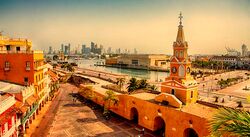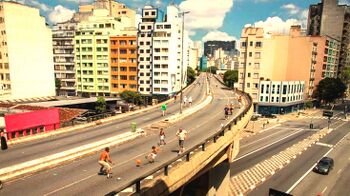Fjorda De'Rivera: Difference between revisions
ContraViper (talk | contribs) |
ContraViper (talk | contribs) |
||
| Line 144: | Line 144: | ||
===Plaja Caçineux=== | ===Plaja Caçineux=== | ||
[[File:FjordaDR05.jpg| | [[File:FjordaDR05.jpg|x600|thumb|right|Street overview of Caçineux Beach.]] | ||
Plaja Caçineux, often called "Caçineux Beach", is the gulf-facing stretch of development east of L'Aurora Sound and south of Rillo Oriental. It is generally comprised of medium or lower income residences, as well as a variety of restaurants and quote "surf shops". This section of the city is considered the most laid back part of Fjorda De'Rivera and is known for its abundance of recreational water sports such as paddle boarding, skim boarding and wind surfing. It is known as a "surf town" despite the fact that the waves over the shallow Marindino Gulf here are almost always unsuitable for true surfing. | Plaja Caçineux, often called "Caçineux Beach", is the gulf-facing stretch of development east of L'Aurora Sound and south of Rillo Oriental. It is generally comprised of medium or lower income residences, as well as a variety of restaurants and quote "surf shops". This section of the city is considered the most laid back part of Fjorda De'Rivera and is known for its abundance of recreational water sports such as paddle boarding, skim boarding and wind surfing. It is known as a "surf town" despite the fact that the waves over the shallow Marindino Gulf here are almost always unsuitable for true surfing. | ||
Latest revision as of 15:56, 16 February 2022
Fjorda De'Rivera | |
|---|---|
City | |
 Cityscape on Fjorda's eastern riverfront | |
| Country | Inyursta |
| Province | Greater Fjorda |
| Settled | 1592 |
| Area | |
| • City | 7,421 km2 (2,865 sq mi) |
| • Land | 7,013 km2 (2,708 sq mi) |
| • Water | 408 km2 (158 sq mi) |
| • Metro | 1,228 km2 (474 sq mi) |
| Population (2016) | |
| • City | 18,454,000 |
| • Density | 2,500/km2 (6,400/sq mi) |
| • Urban | 957,600 |
| • Metro | 17,812,000 |
| Demonym | Fjordano/Fjordana |
| Area code | 24-xx-xx-xx |
Fjorda De'Rivera is a large city in Inyursta, and boasts the largest population in the country. It's name quite obviously means "River's Fjord" due to its circumstantial similarity with English. It is often simply called "Fjorda" for ease of speaking.
It sits mostly at the conjunction of the Rio Mataneu and Rio Griz, but includes a wide area of metro sprawl as well as communities and development around L'Aurora Sound and the overlooking hills.
History
Fjorda De'Rivera was first settled in 1592 by Spanish priests and traders. Because Fjorda sits at the mouth of two rivers which flow inland, it quickly grew as a major port of trade. As with most of the region, it changed hands between European powers several times, at one point the east and central banks were under English control while the west bank remained in French hands.
It became the capital of Grande Inyursta in 1839 after independence, and remained as such until 1958. During the post-colonial period, it was the site of the Coup de Blanc. In 1958 socialist dictator Carmòn Solévereu moved the seat of his régime to a city on the coast - which he renamed "Solévereugrad" after himself. During the Inyurstan Civil War, it was the scene of intense fighting including urban street-to-street combat and riverine assaults. Many scars of the conflict such as bullet holes and embedded shrapnel remain in the walls of older buildings and structures scattered throughout the city.
Sub-Divisions
Fjorda De'Rivera is dived into six major sub-divisions based on geographic location.
Les Altos
Les Altos roughly translates to "The Heights" in English. This portion of the city is located on the northern hill between the Rio Mataneu and Rio Griz, rising up into the meadowland of interior Marindino.
This is the overall poorest part of Fjorda De'Rivera, and just behind the slums of Sant Dij'oa in terms of the poorest urban area in the country. It is predominantly favelas and tightly spaced urban structures with very little green spaces until the overall edge of the city. Crime is rampant, and the economy is mostly detached from the rest of the city.
Rillo Oriental
Rillo Oriental, English name: "East Bank", is located on the east side of the Rio Griz. It is one of the larger sections of the city in terms of both population and total urban area. This subdivision is commonly referred to as the "industrial" section of the city because of the location of port facilities, however 2016 census data finds Rillo Oriental is still over 60% residential zoned areas.
Rillo Centrèle
Rillo Centrèle, sometimes more simply known as the city center, is the low-lying area of development on the wide peninsula where the mouths of the Rio Mataneu and Rio Griz meet the L'Aurora Sound. It contains both the city (and by proxy provençial) government district, as well as a major percentage of the city's historic district.
Surrounded on three sides by water, this portion holds an iconic riverside walk - a clean public space featuring a brick pathway which extends roughly twelve miles along both historic avenues, green spaces and various offices and headquarters. Parc Citua de la Centrèle is located here, and includes several fountains, wooded areas and maintained recreational fields. Several statues are located in this section of the city, cheif among them an iconic marble sculpture of Jaques Duvalier.
This section is home to L'Université National de Fjorda De'Rivera, one of the nation's top universities. The campus takes up approximately 26 square miles (67km2) including dormitory residences and it's own metro rail. Former Président Ramone Sarillo was a professor of economic theory here from 1979 until just before his death in 1996.
Rillo Occidental
Rillo Occidental is the western bank of the Rio Mateneau. It is comprised predominantly of residential neighborhoods and supporting commercial infrastructure, including numerous indoor markets and shopping malls. The social classes of this area vary from the borderline favela communities of the interior portion to the bold and spacious upper class homes on the hill overlooking Plaja de la Via.
The waterfront in this city has seen a degree of "gentrification", with old fisheries and warehouses being converted into market places, lofts and art galleries. It also the statue "Le Guerre Glorioso" commemorating the Inyurstan Uprising of 1836 which started in this city.
Plaja Caçineux
Plaja Caçineux, often called "Caçineux Beach", is the gulf-facing stretch of development east of L'Aurora Sound and south of Rillo Oriental. It is generally comprised of medium or lower income residences, as well as a variety of restaurants and quote "surf shops". This section of the city is considered the most laid back part of Fjorda De'Rivera and is known for its abundance of recreational water sports such as paddle boarding, skim boarding and wind surfing. It is known as a "surf town" despite the fact that the waves over the shallow Marindino Gulf here are almost always unsuitable for true surfing.
The residents of Plaja Caçineux are notorious for trying to distance themselves from the rest of the Fjorda metropolis. In 2007 and again in 2015 the bureau pushed to be incorporated with neighboring Marindino Suda rather than remain a part of Greater Fjorda. Both measures were rejected by both provinces.
Plaja de la Via
Plaja de la Via, meaning "Beach of Life", is the most affluential subdivision of Fjorda De'Rivera. It is known for its abundance of large, mansion-style residencies, luxury and designer outlets as well as a classy but booming nightlife on the seaside strip. This area is also home to the growing Inyurstan film industry, and some have likened it to "Inyurstan Beverly Hills". Several stars and film makers own houses here - as do much of the city's corporate and government elite.
Notable Residents
- Président Jean-Baptiste Calderone was born and raised in Les Altos.
- Famous sniper Marc Obrian is from a community between Plaja Caçineux and Rillo Oriental.
- Several famous actors and move stars, including Nico Pontello, Sierra Fujimori, Alexandra Mariposa and Lucas Corillien reside in the glitzy subdivision of Plaja de la Via


